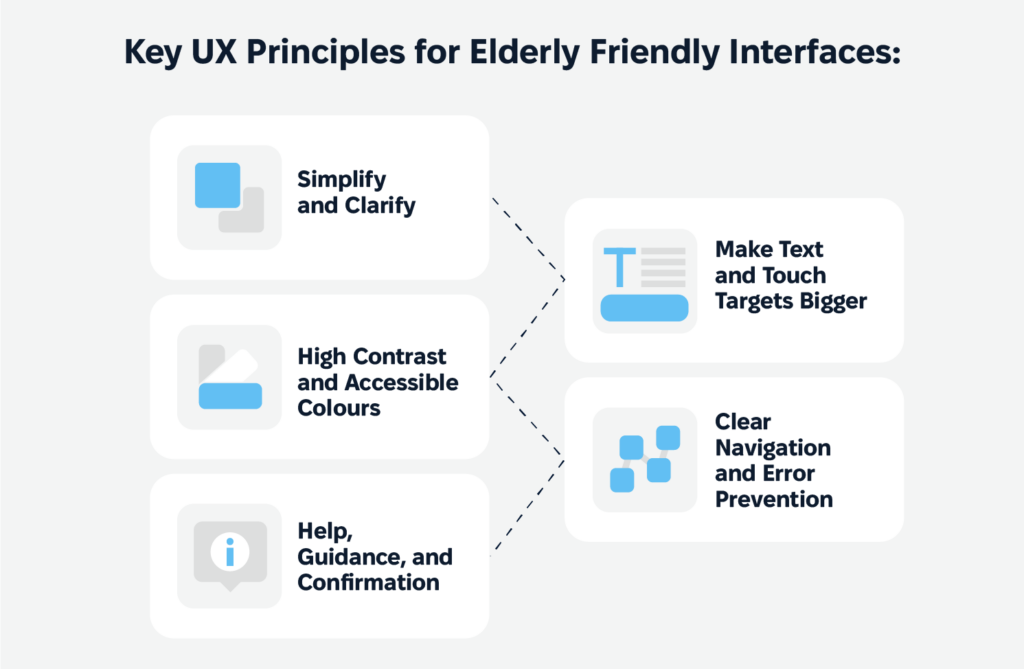Introduction
As the global population ages, the digital world must evolve to meet the needs of older adults. Websites and apps are no longer the exclusive domain of younger users. UX for Aging Populations – millions of seniors rely on digital platforms for healthcare, communication, shopping, and entertainment. Yet, many digital experiences fail to accommodate the physical, cognitive, and emotional realities of aging.
Designing with empathy means understanding these challenges and creating interfaces that empower older users. This blog explores how to build inclusive, accessible, and user-friendly digital experiences for aging populations—enhancing usability, trust, and dignity.
1. Why UX for Aging Populations Matters
Demographic Shift
By 2050, over 2 billion people will be aged 60 or older. This demographic is increasingly online, using smartphones, tablets, and computers to stay connected and informed.
Digital Inclusion
Poor UX can exclude older adults from essential services, social interaction, and information. Inclusive design ensures equal access and participation.
Business Opportunity
Older users often have higher purchasing power and brand loyalty. Designing for them can open new markets and improve customer retention.
2. Understanding the Needs of Aging Users
Empathetic UX begins with understanding the unique needs of older adults. Aging affects users in several ways:
Physical Changes
- Vision: Reduced contrast sensitivity, presbyopia, and difficulty reading small text.
- Motor Skills: Tremors, arthritis, and slower hand-eye coordination.
- Hearing: Difficulty hearing high-pitched sounds or understanding speech.
Cognitive Changes
- Slower information processing
- Memory challenges
- Difficulty with multitasking and complex navigation
Emotional Factors
- Anxiety around technology
- Desire for independence
- Preference for clarity and reassurance
Designing with these realities in mind leads to more usable and respectful experiences.
3. Accessibility Is the Foundation
Accessibility is the first step toward empathetic UX. It ensures that digital products are usable by people with varying abilities.
Visual Accessibility
- Use large, legible fonts (16px minimum)
- High contrast between text and background
- Avoid relying solely on color to convey meaning
- Provide zoom functionality
Motor Accessibility
- Ensure clickable areas are large and spaced out
- Avoid complex gestures or drag-and-drop
- Support keyboard navigation
Auditory Accessibility
- Include captions and transcripts for audio/video
- Avoid autoplaying sound
- Use visual cues alongside audio alerts

Cognitive Accessibility
- Use simple language and clear instructions
- Break tasks into manageable steps
- Avoid clutter and distractions
Follow WCAG (Web Content Accessibility Guidelines) to ensure compliance and usability.
4. Designing Interfaces That Feel Familiar
Older users may not be digital natives. Familiarity reduces cognitive load and builds confidence.
Best Practices
- Use conventional layouts (e.g., top navigation, left-aligned text)
- Avoid trendy UI patterns that require relearning
- Label icons clearly (e.g., use “Print” instead of a printer icon alone)
- Provide tooltips and help text
Consistency across pages and platforms reinforces trust and ease of use.
5. Simplifying Navigation and Tasks
Complex navigation is a major barrier for aging users.
Tips for Simplified UX
- Use clear, descriptive menu labels
- Limit the number of choices per screen
- Provide a visible “Home” button
- Use breadcrumbs to show location
- Offer a search bar with autocomplete
Design flows should be linear and predictable, minimizing decision fatigue.
6. Enhancing Readability and Comprehension
Content must be easy to read and understand.
Typography
- Use sans-serif fonts like Arial or Verdana
- Maintain consistent font sizes and styles
- Avoid italics and all-caps for body text
Language
- Use plain language and avoid jargon
- Write in short sentences and paragraphs
- Use bullet points and headings for structure
Content Design
- Include summaries and key takeaways
- Use visuals to support text
- Provide examples and context
Readable content builds confidence and reduces frustration.

7. Building Trust Through Design
Older users may be more cautious online. Trust is critical.
Trust-Building Elements
- Use secure HTTPS connections
- Display privacy policies and terms clearly
- Avoid pop-ups and aggressive marketing
- Include contact information and support options
- Use real testimonials and recognizable branding
Design should feel safe, transparent, and respectful.
8. Supporting Independence and Control
Empathetic UX empowers users rather than patronizes them.
Design for Autonomy
- Allow users to adjust font size and contrast
- Provide undo options and confirmations
- Avoid auto-submitting forms or auto-playing media
- Offer clear instructions without assuming prior knowledge
Give users control over their experience while offering support when needed.
9. Testing with Aging Users
Designing with empathy means involving aging users in the process.
User Testing Tips
- Recruit participants aged 60+
- Observe interactions and ask open-ended questions
- Test on devices they commonly use
- Use screen recordings and think-aloud protocols
What to Watch For
- Confusion or hesitation
- Missed clicks or misinterpretations
- Feedback on clarity and comfort
Iterate based on real user insights—not assumptions.
10. Case Study: A Senior-Friendly Healthcare Portal
Challenge: A healthcare provider wanted to improve its patient portal for users aged 65+.
UX Improvements:
- Increased font size and contrast
- Simplified navigation with clear labels
- Added video tutorials and help chat
- Enabled appointment booking in 3 steps
Results:
- 40% increase in portal usage among seniors
- 25% reduction in support calls
- 4.7/5 satisfaction rating from older users
Empathetic design led to better outcomes for both users and the organization.

11. Tools and Resources for Designing with Empathy
Accessibility Testing
- WAVE
- Axe
- Lighthouse
Design Systems
- Material Design Accessibility Guidelines
- IBM Carbon Design System
User Research
- AARP UX Guidelines
- Nielsen Norman Group articles on aging and UX
Use these tools to validate and improve your designs.
12. Future Trends in UX for Aging Populations
Voice Interfaces
- Reduce reliance on typing and navigation
- Useful for users with motor or vision impairments
Wearable Integration
- Health tracking and alerts
- Seamless data sharing with caregivers
AI-Powered Personalization
- Adaptive interfaces based on user behavior
- Smart reminders and assistance
Designers must stay ahead of trends while keeping empathy at the core.
Conclusion
Designing for aging populations isn’t just about accessibility—it’s about empathy. It’s about recognizing the dignity, diversity, and potential of older users and creating digital experiences that support their independence, confidence, and joy.
By understanding their needs, simplifying interfaces, and testing with real users, we can build websites and apps that truly serve everyone. Inclusive design isn’t a niche—it’s the future.





